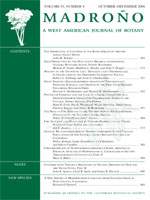Savannas are open communities with a woodland and grassland phase. Some species are restricted to one phase or the other with some in both. The central Texas Edwards Plateau is mainly a savanna community with an east to west rainfall gradient and a tree density gradient with both factors being reduced in the west. We examined gas exchange rates of sun and shade leaves of three perennial species of Asteraceae, Simsia calva (bush sunflower), Wedelia texana (hairy wedelia,) and Brickellia cylindracea (brickell-bush). Maximum photosynthetic rates (Amax), light saturation points (Lsat), ambient light levels, leaf mass per area, leaf conductance, and transpiration rates (E) for sun leaves were significantly greater than shade leaves for all three species. Mean Amax rates were 32.8, 23.2 and 21.2 µmolCO2/m2/s for sun leaves of S. calva, W. texana and B. cylindracea respectively. For shade leaves, rates were 21.3, 15.2 and 12.9 µmolCO2/m2/s respectively for the same species. Mean Rd (dark respiration) rates were 3.00 µmolCO2/m2/s for sun leaves and 1.1 µmolCO2/m2/s for shade leaves of S. calva. Rd rates for sun and shade leaves of W. texana and B. cylindracea were mostly lower but only significantly different for B. cylindracea. There were no significant differences between sun and shade leaves for the initial slope or quantum yield for any of the species. Leaf mass per area was greater for sun leaves of all species. Amax rates for sun leaves were high as expected for sun plants, but Amax rates for shade leaves were fairly high as well, probably because of the relatively open nature of the sub-shrub canopy. Most factors measured were high and suggest that these plants are sun plants or facultative species. These measurements would help explain why these species are present in the full sun, open grassland phase of these central Texas savanna communities and not below the woodland canopy where their growth and survival would be reduced because of lower light levels.
How to translate text using browser tools
1 July 2010
Gas Exchange Rates of Three Sub-Shrubs of Central Texas Savannas
Mitsuru Furuya,
O. W. Van Auken
ACCESS THE FULL ARTICLE

Madroño
Vol. 57 • No. 3
July 2010
Vol. 57 • No. 3
July 2010
CO2 uptake
photosynthesis
savannas
shade leaves
sun leaves




